The issue > Examples of IAS
Taxonomic name: Mnemiopsis leidyi
Common names: Comb jelly
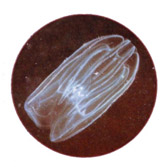 The comb jelly, Mnemiopsis leidyi, is endemic to temperate to subtropical estuaries along the North and South American Atlantic coast. It was first recorded in the Black Sea in 1982, where it became well established, occurring in massive numbers. It also spread rapidly to the Azov, Marmara and Eastern Mediterranean, and towards the end of 1999, was recorded in the Caspian Sea, where its biomass eventually exceeded levels ever recorded in the Black Sea.
The comb jelly, Mnemiopsis leidyi, is endemic to temperate to subtropical estuaries along the North and South American Atlantic coast. It was first recorded in the Black Sea in 1982, where it became well established, occurring in massive numbers. It also spread rapidly to the Azov, Marmara and Eastern Mediterranean, and towards the end of 1999, was recorded in the Caspian Sea, where its biomass eventually exceeded levels ever recorded in the Black Sea.
Mnemiopsis feeds on the same zooplankton as many of the commercial fish species in the area, and had a devastating impact of the fisheries. Landings of anchovy, for example, dropped to one-third of their previous levels, causing losses of around $ 500 million per year. Similar reductions in the biomass of kilka were experienced in the Caspian.
The decrease in zooplankton caused by Mnemiopsis also had impacts on the food web, causing an increase in phytoplankton, and a decline in predatory fish species and seals.
More recently, the accidental introduction into the Black Sea of another comb jelly – Beroe cf ovata – which is a predator of Mnemiopsis, has resulted in a major decline of Mnemiopsis there, and a substantial recovery of the ecosystem.
Photo: CSIRO Sources: GloBallast 2002, Shiganova et al, 2004.
Taxonomic name: Alexandrium spp. and Gymnodinium spp.
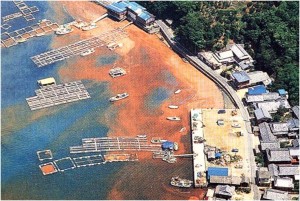 There are at least four species found in Australian waters that are believed to be introduced: Gymnodinium catenatum, Alexandrium minutum, A. tamarensis and A. catenella. All four are bloom-forming species and all produce resting cysts that can lie dormant in bottom sediments for several years. These cysts germinate to produce free swimming cells that reproduce asexually (by division into two cells). When environmental conditions are favourable, cell growth and division is rapid resulting in dense blooms of cells that can extend over large areas. Such blooms are usually short lived (several weeks) but may last for 6-10 weeks in the case of G. catenatum.
There are at least four species found in Australian waters that are believed to be introduced: Gymnodinium catenatum, Alexandrium minutum, A. tamarensis and A. catenella. All four are bloom-forming species and all produce resting cysts that can lie dormant in bottom sediments for several years. These cysts germinate to produce free swimming cells that reproduce asexually (by division into two cells). When environmental conditions are favourable, cell growth and division is rapid resulting in dense blooms of cells that can extend over large areas. Such blooms are usually short lived (several weeks) but may last for 6-10 weeks in the case of G. catenatum.
Impacts: the toxins produced by all four dinoflagellate species are accumulated by filter feeding shellfish such as oysters, mussels and scallops making them toxic to humans and causing Paralytic Shellfish Poisoning (PSP) when eaten. Symptoms of PSP range from nausea, vomiting, dizziness and tingling or numbness in the face in mild cases to muscular paralysis and death from respiratory paralysis in severe cases. Harmful algal blooms (commonly called Red tides) pose a major threat to the viability of both wild and shellfish fisheries and shellfish farming operations. Accumulation of toxins either directly, in the case of filter feeders, or through the food chain can lead to poisoning and sometimes mortality in a wide range of organisms including shellfish, finfish and marine mammals. Intense blooms of toxic (and non toxic) species can also reduce the survival of shellfish and finfish by clogging their gills and by reducing oxygen levels in waters affected by blooms.
Distribution vectors: viable cysts of both A. catenella and A. tamarense have been recovered from sediment in the ballast tanks of ships entering Australian ports which indicates that ballast water is a likely vector for the introduction and translocation of all four species. Translocation of cysts to other areas could also occur as a result of dredging operations or any other activity that redistribute infected sediments or can resuspend cysts in the water column. Cysts may also be moved with oysters or other shellfish seed stock. In infected areas that are subject to bloom events, the uptake of water for ship ballast or for other purposes such as the transport of live seafood products, could entrain motile cells and distribute these to previously uninfected areas.
Extracted from: CSIRO-CRIMP (2000-2001) – Marine Pest Information Sheet.
Taxonomic name: Carcinus maenas
Common names: European shore crab, green crab, strandkrabbe.
 This crab is native to Europe and northern Africa. It has been introduced to the USA, Australia and South Africa. It is euryhaline, and a voracious predator which, in some of the locations where it has been introduced, has caused the decline of other crab and bivalve species. This species has been included among the 100 of the “World’s Worst” invaders (by ISSG).
This crab is native to Europe and northern Africa. It has been introduced to the USA, Australia and South Africa. It is euryhaline, and a voracious predator which, in some of the locations where it has been introduced, has caused the decline of other crab and bivalve species. This species has been included among the 100 of the “World’s Worst” invaders (by ISSG).
General Impacts: a voracious predator. Able to crush mussels, and is a potential threat to mussel farms.
Geographical range: in its native range (north western Europe, including western Baltic Sea), it is abundant on any kind of seashore in shallow waters (upper intertidal to shallow subtidal), including estuaries.
Invasion pathways: aquaculture, aquarium trade, live food trade, ships ballast water, hull fouling.
Local dispersal methods: boats, self-propelled, water currents.
Taxonomic name: Vibrio cholera
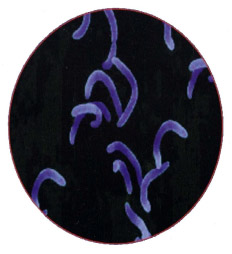 A cholera epidemic (which is caused by Vibrio cholera), commenced in the Eastern Celebes (Indonesia) in 1091, and finally completed its encirclement of the globe in 1991. In South America, the epidemic started on the coast of Peru, and was later documented from several ports in Latin America. This led to the conclusion that it had been introduced by marine traffic. The introduction caused a serious health threat to thousands of people after consumption of seafood caught in affected areas. It then also entered the unchlorinated water supply in Peru’s cities, and caused thousands of deaths.
A cholera epidemic (which is caused by Vibrio cholera), commenced in the Eastern Celebes (Indonesia) in 1091, and finally completed its encirclement of the globe in 1991. In South America, the epidemic started on the coast of Peru, and was later documented from several ports in Latin America. This led to the conclusion that it had been introduced by marine traffic. The introduction caused a serious health threat to thousands of people after consumption of seafood caught in affected areas. It then also entered the unchlorinated water supply in Peru’s cities, and caused thousands of deaths.
Extracted from: Gollasch & Leppakoki, 1999, and Dimijian, 1999.
Taxonomic name: Caulerpa taxifolia
Common names: caulerpa, seaweed.
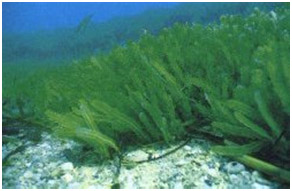 Caulerpa taxifolia was introduced to the Mediterranean around 1984, possibly as waste from the Monaco Aquarium. It is a tropical seaweed but it has adapted well to colder waters and wherever it has established itself. The strain of Caulerpa taxifolia which has colonized the Mediterranean has some unusual morphological and physiological characteristics with respect to the tropical populations (longer fronds, a higher population density, adaptation to a large spectrum of temperatures, higher concentrations of toxic metabolites). The competitive success of Caulerpa taxifolia over Mediterranean native communities seems to be related to these characteristics but also to the production of toxic secondary metabolites.
Caulerpa taxifolia was introduced to the Mediterranean around 1984, possibly as waste from the Monaco Aquarium. It is a tropical seaweed but it has adapted well to colder waters and wherever it has established itself. The strain of Caulerpa taxifolia which has colonized the Mediterranean has some unusual morphological and physiological characteristics with respect to the tropical populations (longer fronds, a higher population density, adaptation to a large spectrum of temperatures, higher concentrations of toxic metabolites). The competitive success of Caulerpa taxifolia over Mediterranean native communities seems to be related to these characteristics but also to the production of toxic secondary metabolites.
General Impacts: dominant colonization by Caulerpa taxifolia leads to a considerable decrease of biodiversity. The rate of impoverishment of a population colonized by C. taxifolia reaches 75% if we count only the algae of Mediterranean communities. Most of the indigenous algae regress and tend to disappear. They suffer a drastic decrease of their biomass, which can reach 100%. C. taxifolia competes also with the Posidonia oceanica meadows, which is one of the most important ecosystems of the Mediterranean. When both species are in direct competition, the size thickness, number and longevity of the Posidonia leaves decrease and necrotic areas appear on them. The species composition of the invertebrate meiofauna and macrofauna is strongly modified by the presence of C. taxifolia. In terms of the number of individuals, the Amphipoda have been the most affected group while an increase in diversity was observed in Molluscs. For fish, the species number, the number of individuals, the biomass and the mean weight are significantly lower in habitats colonised by C. taxifolia.
Geographical Range: it is widely distributed throughout the tropical seas and is native to Brazil, Venezuela, Colombia, Costa Rica, Antilles, Gulf of Guinea, Red Sea, Somalia, Kenya, Tanzania, Madagascar, Maldives, Seychelles, Pakistan, India, Sri Lanka, Bangladesh, Malaysia, Indonesia, Philippines, Vietnam, China, Japan, Hawaii, Fiji, New Caledonia, North Australia. It was introduced to the Mediterranean Sea in the 1980s and covers more than 4630 ha. It now affects Monaco, France, Italy, Spain, Croatia and Tunisia. Recently it has been discovered in the Pacific and Atlantic Oceans, in East Australia, and in the summer of 2000, off southern California and southern Florida (USA).
Invasion pathways to new location: aquarium trade (intentional release of aquaria content), ships (accidental transport by anchors etc).
Local dispersal methods: boat (accidental transport by anchors etc), fishing activities (nets).
Taxonomic name: Dreissena polymorhpa
Common name: zebra mussel.
 Zebra mussels are native to the Caspian and Black Seas. They are now established in the UK, Western Europe, Canada and the USA. They compete with zooplankton for food, thus affecting natural food webs. They also interfere with the ecological functions of native molluscs and cause great economic damage. This species has been nominated as among 100 of the “World’s Worst” invaders.
Zebra mussels are native to the Caspian and Black Seas. They are now established in the UK, Western Europe, Canada and the USA. They compete with zooplankton for food, thus affecting natural food webs. They also interfere with the ecological functions of native molluscs and cause great economic damage. This species has been nominated as among 100 of the “World’s Worst” invaders.
General Impacts: zebra mussels filter organic and inorganic particles between 7 and 400 microns, competing with native planktivores for food. The net result is a sedimentation of previously suspended organic matter in the form of faeces and pseudofaeces, shifting energy and nutrient balances from the pelagic to the benthic zone. Increases in water clarity favour increased photosynthesis by rooted aquatic macrophytes, and negatively affect fish species that prefer slightly turbid conditions, such as walleye. Removal of green algae gives cyanobacteria a competitive advantage, as zebra mussels will stop filtering in the presence of cyanobacteria. Zebra mussels settle in high numbers on native mussels (Unionidaceae), causing suffocation, starvation, and energetic stress leading to death. Loss of native mussel populations has increased dramatically where zebra mussels are present, particularly in the Great Lakes and Hudson and Mississippi rivers. Dense colonization of hard substrates is beneficial to benthic invertebrates, as habitat complexity increases as does availability of organic matter. Spawning reefs of fishes such as lake trout are negatively affected by zebra mussel colonies.
Geographical Range: native range includes the Black, Caspian, and Azov seas; since the 1700’s its range has expanded westward to most of western Europe, UK, and North America, where it is found in the Great Lakes and all of the major river drainages east of the Rocky Mountains.
Invasion pathways: aquarium trade (possibly via aquarium dumping); floating vegetation/debris; ships ballast water (egg Great Lakes); ship/boat hull fouling (introduced to smaller lakes by overland transport on boat hulls and trailers); translocation of machinery.
Local dispersal methods: aquaculture (larvae may be transported during fish stocking); boats (biofouling); on animals, people (e.g. scuba diver’s wetsuits, or in scientific sampling equipment); and water currents (range expansion within North America has been very rapid due to downstream transport of planktonic larvae).
Taxonomic name: Neogobius melanostomus
Common name: round goby.
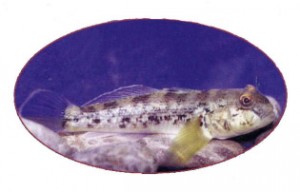 The round goby is native to the Black Sea, Caspian Sea, Sea of Azov and related tributaries, but is now established in waterways of the USA and Canada. The species has been found to prey on darters, other small fish, and the eggs and fry of lake trout in laboratory experiments. It may also feed on the eggs and fry of sculpins, darters and longperch.
The round goby is native to the Black Sea, Caspian Sea, Sea of Azov and related tributaries, but is now established in waterways of the USA and Canada. The species has been found to prey on darters, other small fish, and the eggs and fry of lake trout in laboratory experiments. It may also feed on the eggs and fry of sculpins, darters and longperch.
General Impacts: the numbers of native fish species have declined in areas where this goby has become abundant; sculpins have been particularly affected. This species has been found to prey on darters, other small fish, and lake trout eggs and fry in laboratory experiments. They also may feed on eggs and fry of sculpins, darters and longperch. Adults aggressively defend spawning sites and may occupy prime spawning areas, keeping natives out. Walleye anglers in Detroit report that at times all they can catch are gobies, which eagerly attack bait. This goby is established and apparently undergoing a population explosion in the Great Lakes. The goby was considered extremely abundant in the St. Clair River in 1994. Short trawls made in Lake Erie in October 1994 turned up 200 individuals. Frequent trawling in 1995 collected over 3,000 individuals near Fairport Harbor, Ohio (Knight, personal communication). Densities in Calumet Harbor exceed 20 per square meter (Marsden and Jude 1995). Gravid females and different size classes have been found in Lake Erie (Cavender, personal communication). Only two individuals have been reported from Lake Superior.
Geographical Range: marine to fresh water. The native range includes Eurasia including Black Sea, Caspian Sea, and Sea of Azov and tributaries (Miller 1986). This species was introduced into the St. Clair River and vicinity on the Michigan-Ontario border where several collections were made in 1990 on both the U.S. and the Canadian side. It is now found in waterways of the USA (States of Illinois, Indiana, Ohio, Pennsylvania, Wisconsin, Minnesota, New York) and of Canada (Ontario and Quebec).
Invasion pathways to new location: introduced into the Great Lakes via freighter ballast. Spread to Lake Superior by freighters operating within the Great Lakes.
Remarks: the diet of round gobies collected in the United States consists of aquatic insects, zebra mussels, and some native snails. Studies have shown a single goby can eat as many as 78 zebra mussels per day.
You can also read the WWF report: Silent Invasion The spread of marine invasive species via ships’ ballast water.
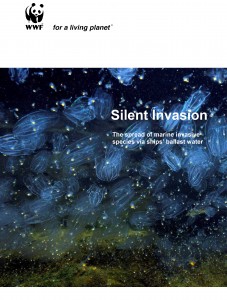
 The comb jelly, Mnemiopsis leidyi, is endemic to temperate to subtropical estuaries along the North and South American Atlantic coast. It was first recorded in the Black Sea in 1982, where it became well established, occurring in massive numbers. It also spread rapidly to the Azov, Marmara and Eastern Mediterranean, and towards the end of 1999, was recorded in the Caspian Sea, where its biomass eventually exceeded levels ever recorded in the Black Sea.
The comb jelly, Mnemiopsis leidyi, is endemic to temperate to subtropical estuaries along the North and South American Atlantic coast. It was first recorded in the Black Sea in 1982, where it became well established, occurring in massive numbers. It also spread rapidly to the Azov, Marmara and Eastern Mediterranean, and towards the end of 1999, was recorded in the Caspian Sea, where its biomass eventually exceeded levels ever recorded in the Black Sea. There are at least four species found in Australian waters that are believed to be introduced: Gymnodinium catenatum, Alexandrium minutum, A. tamarensis and A. catenella. All four are bloom-forming species and all produce resting cysts that can lie dormant in bottom sediments for several years. These cysts germinate to produce free swimming cells that reproduce asexually (by division into two cells). When environmental conditions are favourable, cell growth and division is rapid resulting in dense blooms of cells that can extend over large areas. Such blooms are usually short lived (several weeks) but may last for 6-10 weeks in the case of G. catenatum.
There are at least four species found in Australian waters that are believed to be introduced: Gymnodinium catenatum, Alexandrium minutum, A. tamarensis and A. catenella. All four are bloom-forming species and all produce resting cysts that can lie dormant in bottom sediments for several years. These cysts germinate to produce free swimming cells that reproduce asexually (by division into two cells). When environmental conditions are favourable, cell growth and division is rapid resulting in dense blooms of cells that can extend over large areas. Such blooms are usually short lived (several weeks) but may last for 6-10 weeks in the case of G. catenatum. This crab is native to Europe and northern Africa. It has been introduced to the USA, Australia and South Africa. It is euryhaline, and a voracious predator which, in some of the locations where it has been introduced, has caused the decline of other crab and bivalve species. This species has been included among the 100 of the “World’s Worst” invaders (by ISSG).
This crab is native to Europe and northern Africa. It has been introduced to the USA, Australia and South Africa. It is euryhaline, and a voracious predator which, in some of the locations where it has been introduced, has caused the decline of other crab and bivalve species. This species has been included among the 100 of the “World’s Worst” invaders (by ISSG). A cholera epidemic (which is caused by Vibrio cholera), commenced in the Eastern Celebes (Indonesia) in 1091, and finally completed its encirclement of the globe in 1991. In South America, the epidemic started on the coast of Peru, and was later documented from several ports in Latin America. This led to the conclusion that it had been introduced by marine traffic. The introduction caused a serious health threat to thousands of people after consumption of seafood caught in affected areas. It then also entered the unchlorinated water supply in Peru’s cities, and caused thousands of deaths.
A cholera epidemic (which is caused by Vibrio cholera), commenced in the Eastern Celebes (Indonesia) in 1091, and finally completed its encirclement of the globe in 1991. In South America, the epidemic started on the coast of Peru, and was later documented from several ports in Latin America. This led to the conclusion that it had been introduced by marine traffic. The introduction caused a serious health threat to thousands of people after consumption of seafood caught in affected areas. It then also entered the unchlorinated water supply in Peru’s cities, and caused thousands of deaths. Caulerpa taxifolia was introduced to the Mediterranean around 1984, possibly as waste from the Monaco Aquarium. It is a tropical seaweed but it has adapted well to colder waters and wherever it has established itself. The strain of Caulerpa taxifolia which has colonized the Mediterranean has some unusual morphological and physiological characteristics with respect to the tropical populations (longer fronds, a higher population density, adaptation to a large spectrum of temperatures, higher concentrations of toxic metabolites). The competitive success of Caulerpa taxifolia over Mediterranean native communities seems to be related to these characteristics but also to the production of toxic secondary metabolites.
Caulerpa taxifolia was introduced to the Mediterranean around 1984, possibly as waste from the Monaco Aquarium. It is a tropical seaweed but it has adapted well to colder waters and wherever it has established itself. The strain of Caulerpa taxifolia which has colonized the Mediterranean has some unusual morphological and physiological characteristics with respect to the tropical populations (longer fronds, a higher population density, adaptation to a large spectrum of temperatures, higher concentrations of toxic metabolites). The competitive success of Caulerpa taxifolia over Mediterranean native communities seems to be related to these characteristics but also to the production of toxic secondary metabolites. Zebra mussels are native to the Caspian and Black Seas. They are now established in the UK, Western Europe, Canada and the USA. They compete with zooplankton for food, thus affecting natural food webs. They also interfere with the ecological functions of native molluscs and cause great economic damage. This species has been nominated as among 100 of the “World’s Worst” invaders.
Zebra mussels are native to the Caspian and Black Seas. They are now established in the UK, Western Europe, Canada and the USA. They compete with zooplankton for food, thus affecting natural food webs. They also interfere with the ecological functions of native molluscs and cause great economic damage. This species has been nominated as among 100 of the “World’s Worst” invaders. The round goby is native to the Black Sea, Caspian Sea, Sea of Azov and related tributaries, but is now established in waterways of the USA and Canada. The species has been found to prey on darters, other small fish, and the eggs and fry of lake trout in laboratory experiments. It may also feed on the eggs and fry of sculpins, darters and longperch.
The round goby is native to the Black Sea, Caspian Sea, Sea of Azov and related tributaries, but is now established in waterways of the USA and Canada. The species has been found to prey on darters, other small fish, and the eggs and fry of lake trout in laboratory experiments. It may also feed on the eggs and fry of sculpins, darters and longperch.